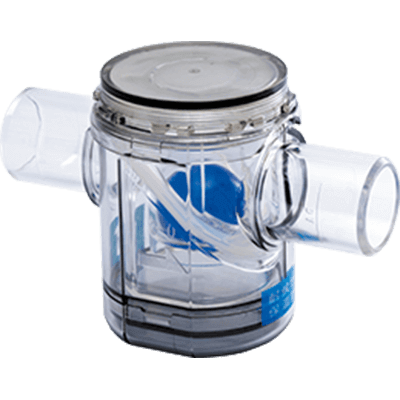What Is a Drain Trap?

A drain trap is a device that discharges condensed water generated by condensation of moisture in compressed air or water vapor.
Generally, compressed air is cooled before use, and the moisture in the compressed air condenses to water. If used as is, it will adversely affect equipment, so we apply drain traps to separate and discharge only the condensate water.
Another name for a drain trap for water vapor is a steam trap or vapor trap. When water vapor is used in equipment, it condenses to water, and a drain trap drains it as condensate.
A U-shaped trap section or drain trap is also installed in the middle of the drain piping to prevent foul odors and insects from entering the equipment from the outside. Drain traps are often used in air conditioners and commercial freezing and refrigeration equipment.
Uses of Drain Traps
There are three main types of applications for drain traps.
- Drain Trap for Compressed Air
Compressed air is an inexpensive and common power source at manufacturing sites. A drain trap is used to drain condensate generated during compressed air use. It is necessary for equipment maintenance and maintaining the product’s quality after compressed air use.
Specifically, it is used for air cylinders/actuators, rock drills, pneumatic hammers, pneumatic presses, and pneumatic tools in machinery and equipment. It is also used for draining/chip removal of machined parts, cooling during machining, air sealing, pneumatic conveying, etc.
- Drain Trap for Water Vapor
A drain trap for water vapor is a type of automatic valve used for applications where only condensate is discharged from water vapor to prevent vapor leakage as much as possible. It is essential for equipment that uses steam. Specifically, it is used in jacketed kettles, heat exchangers, humidifiers, washing machines, etc. 3.
- Drain Trap for Drainage
Drain traps are installed in the middle of drain pipes to prevent the backflow of foul odors from drain drains. Drain traps are used in drainage pipes for air conditioners, commercial refrigeration and freezing equipment, showcases, etc.
Principle of Drain Traps
The principle of drain traps differs depending on the type of drainage.
- Disc Type
No power supply is required. The internal disc moves up and down at short intervals of several seconds to discharge condensate. Although it does not clog easily with debris, it has the disadvantage of discharging compressed air and water vapor. A bimetal valve is used for water vapor. The valve opens and closes depending on the temperature.
- Bellows Type
The bellows type is filled with an enclosed liquid, and the valve opens and closes by expanding and contracting the bellows using the volume change of the enclosed liquid and vapor caused by temperature change. The bellows type is used for water vapor.
- Float Type
When condensate accumulates, a float floats up, and a lever connected to the float moves to discharge the condensate water. This type does not require a power source and can discharge almost only condensate, with negligible leakage of compressed air or water vapor. Still, the narrow outlet may become clogged with impurities.
- Timer Type
Compared to the disc and float types, the timer type is suitable for discharging significant amounts of condensate or condensate-containing debris. Since it requires a power source and discharges at a set time, air and vapor leakage are more significant when the condensate is small.
- Electromagnetic Type
The amount of condensate is ascertained by a capacitance sensor and discharged using a solenoid valve. No unnecessary loss occurs, and the amount of condensate can be monitored. Maintenance costs will increase due to the need for a power supply and the large number of parts required to mount the sensor.
Other Information about Drain Traps
- Cleaning of Drain Traps
Drain traps must be cleaned after continuous use because dirt and debris can clog the traps. If debris adheres to the seat of the drain trap, the valve will be left blowing, which may cause condensation to enter the equipment side. It is essential to clean the drain trap regularly.
Oil-fed compressors often contain oil, and the Water Pollution Control Law prohibits the discharge of condensate containing untreated oil. Condensate treatment equipment (filters), oil separation tanks, or microorganisms decompose the oil before it is discharged as condensate.
- Difference Between a Drain Trap for Air and a Drain Trap for Steam
The difference between a drain trap for compressed air or other gases and a drain trap for steam varies depending on the fluid to be handled. A drain trap for compressed air is installed in a compressed air line to drive equipment, etc., to prevent moisture from entering the equipment. This prevents corrosion inside the equipment and wall thinning due to erosion.
A drain trap for steam is installed in the steam line to separate and drain condensate. Its primary role is to maintain equipment performance and prevent hammering caused by condensate hitting the piping or by sudden pressure changes. Many types of drain traps for steam use valves that open and close using temperature changes caused by condensate.